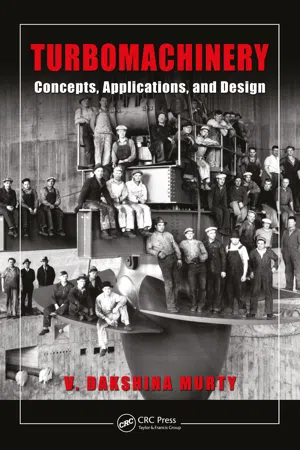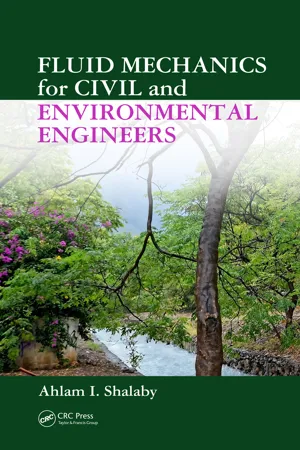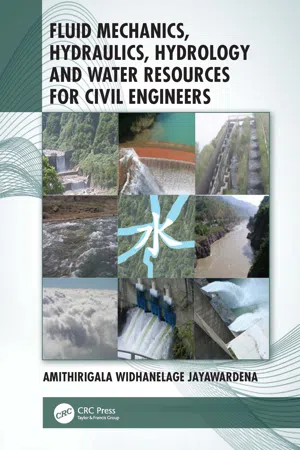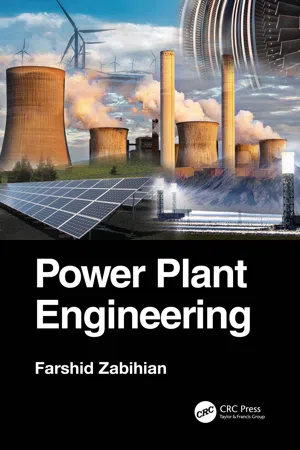Technology & Engineering
Impulse Turbine
An impulse turbine is a type of water turbine that operates on the principle of impulse. It uses the kinetic energy of a high-velocity jet of water to drive the turbine blades. The force of the water causes the turbine to rotate, converting the kinetic energy of the water into mechanical energy.
Written by Perlego with AI-assistance
Related key terms
Related key terms
1 of 4
Related key terms
1 of 3
9 Key excerpts on "Impulse Turbine"
- eBook - ePub
Turbomachinery
Concepts, Applications, and Design
- V. Dakshina Murty(Author)
- 2018(Publication Date)
- CRC Press(Publisher)
Hydraulic turbines are classified broadly into impulse and reaction turbines. Pelton wheel is the most common form of impulse type turbine while Francis turbine and Kaplan turbine are reaction type. A guide to the selection of turbines based on the head and power requirement is shown in Figure 4.2. Pelton wheels are most suitable for high heads and low flow rates. Kaplan turbines (somewhat the reverse of an exhaust fan!) are suited to high flows and low heads. This is related to the specific speeds, as discussed in Chapter 2, wherein it was shown that higher heads and lower flows give rise to lower specific speeds (Impulse Turbines) and lower heads with higher flows imply higher specific speeds (reaction turbines). A detailed discussion on turbine selection, plant capacity determination, and economic and hydrologic analysis can be found in Warnick et al. (1984).FIGURE 4.2 Guide to selecting hydraulic turbines. (From Walters, R. N. and Bates, C. G., (1976) Selecting Hydraulic Reaction Turbines, Engineering Monograph No. 20, Bureau of Reclamation, U.S. Department of the Interior, Washington, D.C.)4.2 Impulse TurbinesAn Impulse Turbine (in the context of hadraulic turbines) is one in which the total pressure drop of the fluid occurs inside one or more nozzles and there is no drop in pressure as the fluid flows through the rotor. Such turbines are most useful when water is available at very high heads, that is, with large potential energy. When such large heads are available, the potential energy is first converted into kinetic energy by letting the fluid flow through large pipes called penstock , and the high kinetic energy fluid then impinges on vanes or buckets. Thus, kinetic energy is converged into force, which results in torque on the shaft. A small part of the kinetic energy is lost in fluid friction on the wheels, and another small part is lost as kinetic energy of the fluid leaving the vanes.4.2.1 Pelton WheelA hydraulic Impulse Turbine is called a Pelton wheel , which is by far the most important machine among the hydraulic turbines. It has evolved from the development of the earliest hydraulic turbines, frequently called waterwheels . It is named after Lester A. Pelton (1829–1908), who patented it in 1890.The locations of some Pelton turbine installations are shown in Table 4.1. A brief perusal of the table shows that the range of specific speeds is well within the accepted limits for Impulse Turbines indicated in Table 2.2. - eBook - ePub
- Don M. Pirro, Martin Webster, Ekkehard Daschner(Authors)
- 2017(Publication Date)
- CRC Press(Publisher)
14 Steam TurbinesIn a steam turbine, hot steam at a pressure above atmospheric is expanded in the nozzles where part of its heat energy is converted to kinetic energy. This kinetic energy is then converted to mechanical energy in the turbine runner, either by the impulse principle or the reaction principle. If the nozzles are fixed and the jets directed toward movable blades, the jet’s impulse force pushes the blades forward. If the nozzles are free to move, the reaction of the jets pushes against the nozzles, causing them to move in the opposite direction.In small, purely Impulse Turbines, steam is expanded to exhaust pressure in a single set of stationary nozzles. As a result of this single expansion, the steam issues from the nozzles in jets of extremely high velocity. To obtain maximum power from the force of the jets’ impact on a single row of moving blades, the blades must move at about half the velocity of the jets. Thus, single-stage Impulse Turbines operate at very high speeds. To reduce rotative speed while maintaining efficiency, the high velocity can be absorbed in more than one step, which is called velocity compounding.Such a turbine (Figure 14.1 ) has one velocity compound stage followed by four pressure compounded stages. In the velocity compounded stage, steam is first expanded in the stationary nozzles to high velocity. This velocity is reduced in two steps through the first two rows of moving blades. The steam is then expanded again in a set of stationary nozzles and delivered to the first pressure stages. In each case, velocity is increased and pressure is decreased in the stationary nozzles. In the moving blades, velocity decreases but the pressure remains constant. The graph at the bottom of Figure 14.1 - Mei Zu-yan(Author)
- 2018(Publication Date)
- Routledge(Publisher)
Chapter 5Construction of Impulse Turbines
G. Borciani5.1 General
The Impulse Turbine has a basic feature, in that all the available energy in the water is fully converted in the distributor system into kinetic energy which is transferred to the runner according to the impulse principle. This is the first difference between impulse and reaction turbines, the second is that the impulse (or action) turbine has a partial water admission, that is water impinges on the runner at one or several points on the periphery only (see Volume Hydraulic Design of Hydraulic Machinery of this Book Series.Small turbines, like the inclined jet turbine and the cross–flow turbines, are usually classified as Impulse Turbines although they have some degree of reaction. These turbines will be described in detail in Chapter 10 .The most important Impulse Turbine is the Pelton turbine, named after L. A. Pelton who in 1880 invented the central ridge (splitter) for the buckets. Around 1900, A. Dohle used a double–elliptic shape bucket and a needle for the control of discharge for the first time.Most Pelton turbines built up to 1960 are of the horizontal type. Only after the wider application of the vertical design did the power of Pelton turbines exceed the 100MW mark, see Figure 5.1 . The two units at the Sy–sima plant (Norway, 1981) each with five jets are rated at 315MW at n = 5s −1 (300rpm) under a specific hydraulic energy 1 E of 8690· kg −1 (H = 885m ). The three Pelton turbines at Reisseck (Austria, 1970) operate under the highest value of E in the world of 17318 J · kg −1 (H = 1765m ).The operating scheme of a Pelton turbine is fairly simple, as shown by the horizontal two–jet machine in Figure 5.2 . Water from the penstock 1 passes through the spherical valve 2 which has a two–fold task: to permit inspection and maintenance of the turbine, and stopping the machine in an emergency, for example the failure of the normal closing system. The feeding system (distributor) consists of the two branches 4 connecting the spherical valve to the two nozzles 5 through which the energy of the water is transformed into kinetic energy in the form of a free jet. The jet impinges on a series of buckets 6 set at the periphery of the runner and causes it to rotate. In the diagram, D is the jet circle diameter and d 0- eBook - ePub
- D. Yogi Goswami, Frank Kreith, D. Yogi Goswami, Frank Kreith(Authors)
- 2017(Publication Date)
- CRC Press(Publisher)
12Hydraulic Turbines
Roger E.A. Arndt and Leonardo P. Chamorro CONTENTS 12.1 General Description 12.1.1 Typical Hydropower Installation 12.1.2 Turbine Classification 12.1.2.1 Impulse Turbines 12.1.2.2 Reaction Turbines 12.2 Principles of Operation 12.2.1 Power Available and Efficiency 12.2.2 Similitude and Scaling Formulae 12.3 Factors Involved in Selecting a Turbine 12.3.1 Performance Characteristics 12.3.1.1 Impulse Turbines 12.3.1.2 Reaction Turbines 12.3.1.3 Performance Comparison 12.3.2 Speed Regulation 12.3.3 Cavitation and Turbine Setting 12.4 Performance Evaluation 12.4.1 Model Tests 12.5 Numerical Simulations 12.6 Field Tests 12.7 Other Concepts: Hydrokinetic Turbines Defining Terms References Further InformationA hydraulic turbine is a mechanical device that converts the potential energy associated with a difference in water elevation (head ) into mechanical work. Modern hydraulic turbines are the result of many years of gradual development. Economic incentives have resulted in the development of very large units (exceeding 800 MW in capacity, i.e., two orders of magnitude larger than their wind counterparts) with efficiencies that are sometimes in excess of 95%.However, the emphasis on the design and manufacture of very large turbines has shifted to the production of smaller units, especially in developed nations, where much of the potential for developing large base-load plants has been realized. At the same time, the sustained increase in the cost of energy has made many smaller sites economically feasible and has greatly expanded the market for smaller turbines. The increased value of energy also justifies the cost of refurbishment and increasing the capacity of older facilities with modern runners having higher efficiency and greater capacity. The introduction of high-performance computational tools in the last decade has had considerable influence on the design of hydraulic systems, their operation, and control. - Ahlam I. Shalaby(Author)
- 2018(Publication Date)
- CRC Press(Publisher)
illustrated in Figure 4.27. The impulse of the jet of fluid striking the blades generates the torque. The total head, H = (p / γ) + (v 2 / 2 g) + z (minus any head losses) of the incoming fluid flow is converted to a large velocity head, v 2 / 2 g at the nozzle exit (forced jet). Thus, because the fluid in the forced jet is exposed to the atmosphere, the hydraulic energy delivered to the turbine is all kinetic energy. Because the diameter of the nozzle is small and thus limits the magnitude of the flowrate, Impulse Turbines are efficient for fluid flow systems with small flowrates, Q and large heads, h turbine. Large heads, h turbine may be created by locating the turbine nozzle at an elevation that is significantly below the water source, as illustrated in Figure 4.29. A reaction turbine, such as a Francis or a Kaplan turbine extracts hydraulic power from a fluid flowing (at a high pressure) at the specified flowrate, Q in a pipe or open channel, which rotates the vanes of the turbine, filling the casing with fluid, and leaving the turbine through a draft tube, converting it to shaft power, as illustrated in Figure 4.28. Because the fluid is flowing under a high pressure, the hydraulic energy delivered to the turbine is both pressure energy and kinetic energy. And, because the magnitude of the flowrate in the pipe or open channel is limited only by the selected design pipe or channel size, reaction turbines are efficient for fluid flow systems with large flowrates, Q and small heads, h turbine. In order for the reaction turbine to operate properly, the flow leaving the turbine must be submerged as it leaves the turbine through a draft tube, which is an integral part of a reaction turbine, as illustrated in Figure 4.30. The draft tube has a gradual expansion in diameter (conical diffuser) and is designed to serve two main purposes- eBook - ePub
Hydroelectric Energy
Renewable Energy and the Environment
- Bikash Pandey, Ajoy Karki(Authors)
- 2016(Publication Date)
- CRC Press(Publisher)
10 Impulse Turbines Impulse Turbines direct high-velocity jets at runner blades to convert kinetic energy to shaft power. Nozzles are used to transform the potential energy of the water to kinetic energy carried by the jets. Only a few of the blades of the runner interact with each jet at any time, and the discharge through an Impulse Turbine is largely independent of the speed of rotation of the runner. Other features that distinguish Impulse Turbines from reaction turbines are that (a) the change in water pressure occurs in the nozzles of the machine and not along the turbine rotor and (b) impingement of the jet on the runner and its rotation both take place at atmospheric pressure. Pelton turbines are the most widely used among Impulse Turbines covering a remarkable range from less than a kilowatt to single units producing hundreds of megawatts. In addition to Peltons, this chapter explores the Turgo and cross-flow Impulse Turbines, which cover the micro hydro to small hydro range from 1 kW typically up to 5 MW. The Pelton and Turgo are tangential flow turbines with jets striking the periphery of the runner and exiting from the sides whereas the cross-flow is a radial flow turbine with the water flowing along the radius toward the shaft of the runner after striking the first set of blades. 10.1 PELTON TURBINES Pelton turbines utilize high-velocity jets from one or more nozzles to strike buckets on a spinning runner. There are typically between 20 and 25 buckets mounted on the periphery of the runner shown in Figure 10.1. The buckets have the shape of two half bowls joined together with a sharp ridge between them. When the turbine is operating efficiently, upon hitting the bucket the jet loses most of its energy, and the exit velocity of the water is small - eBook - ePub
Thermal Power Plant
Design and Operation
- Dipak Sarkar(Author)
- 2015(Publication Date)
- Elsevier(Publisher)
In a steam turbine the inlet and exhaust pressures and the inlet temperature of the steam determine the theoretical energy available at the turbine inlet. To release the energy inside the turbine, steam flows over an alternate series of fixed and moving blades and as a result expands from high pressure to low pressure. A turbine stage consists of a stationary set of blades or nozzles, followed by a moving set called buckets or rotor blades. These two different blade types together cause steam to do mechanical work on the rotor. The stationary nozzles turn and accelerate steam converting the potential energy of steam (pressure) into kinetic energy (velocity). The buckets convert the kinetic energy of steam leaving the nozzles into both an impulse force (due to a change in direction of the steam) and a reaction force (due to a pressure drop across rotating blades), causing the shaft to rotate and generate power.In the simplest single-disc steam turbine the expansion of steam is achieved from its initial pressure to its final one in a single nozzle located in front of the blades of the rotating disc (Figure 6.10 ). With the drop in steam pressure in the nozzle its heat content reduces, raising the velocity of the steam coming from the nozzle. Thus, the resulting kinetic energy of the jet of steam exerts an impulsive force on the blades performing mechanical work on the rotor.Figure 6.10 Single disc steam turbine.6.2.1 Impulse and reaction
In the impulse design the complete process of expansion of steam takes place primarily in stationary nozzles, and the kinetic energy is transformed into mechanical work on the turbine blades without any further expansion. An Impulse Turbine has fixed nozzles that orient steam flow into high-speed jets. Moving rotor blades, shaped like buckets, absorb the kinetic energy of these jets and convert it to mechanical work, resulting in shaft rotation as the steam jet changes direction. A pressure drop occurs only across stationary blades, with a net increase in steam velocity across the stage (Figure 6.11 ).Figure 6.11 Change in pressure and velocity in Impulse Turbine.Source: Fig. 2, P5, Introduction [3] - Amithirigala Widhanelage Jayawardena(Author)
- 2021(Publication Date)
- CRC Press(Publisher)
Hydraulic ram can be used when there is a large volume of water flowing at a pressure higher than necessary. Some of the dynamic pressure energy of the main body of water is used to increase the static pressure on part of the supply. For the hydraulic ram to function, there must be a source of water at an elevation higher than where the ram is located. The water is allowed to run through a pipeline towards the ram, which has a valve to let the water in. When the flow reaches its maximum velocity, the inlet valve is suddenly closed, resulting in a build-up of pressure due to the inertia of the flow. The build-up pressure then opens an exit valve forcing the fluid to flow into the delivery pipe. The pressure in the ram falls, and the entry valve opens allowing more water to flow in and build up the pressure. This cycle is repeated. The water wheel used in some parts of the world in ancient times operates on the same principle.12.2.3 Rotodynamic type (turbomachines)
In this type of machines, there is a transformation between pressure and velocity heads. There is a significant velocity change across the pump. If the valves in a rotodynamic machine were closed, there will only be an increase in temperature. The casing will not burst. There are three common rotodynamic type pumps; namely, centrifugal pumps, axial flow pumps and mixed flow pumps. They are used mainly for high-flow and low-pressure situations.12.3 Types of turbines
There are two main categories of turbines; namely, Impulse Turbines and reaction turbines. Pelton wheel is an example of an Impulse Turbine, whereas Francis and Kaplan turbines are reaction type of turbines.In both types, fluid passes through a runner having blades. The momentum of the fluid in the tangential direction is changed and so a tangential force on the runner is produced. The runner rotates and does work. The energy in the fluid is reduced.In Impulse Turbines, there is no change in static pressure across the runner which is open and at atmospheric pressure. The energy change is from kinetic to mechanical. In reaction turbines, static pressure decreases as the fluid passes through the runner which is enclosed.For any turbine, the fluid energy is in the form of pressure. In water turbines, it is the difference between the upper and lower water levels that gives this pressure. In steam turbines, it is the steam pressure produced by heat. In gas turbine, it is the gas pressure produced by chemical energy.12.4 Centrifugal pump
The flow in a centrifugal pump is radially outwards. They are so called because the centrifugal force or the variation of pressure due to rotation is an important factor in their operation. A rotating impeller provides the energy to the fluid in the form of a velocity head which is converted into a pressure head as the fluid leaves the pump. There is a pronounced change in the radius from inlet to outlet. Centrifugal pumps operate efficiently for water and other liquids with low viscosity. They are not suitable for high-viscosity fluids and high pressure. Multi-stage pumps can be used to deliver high pressure.- eBook - ePub
- Farshid Zabihian(Author)
- 2021(Publication Date)
- CRC Press(Publisher)
Essentially, each stage (combined stationary and rotational blades) is similar to a single-stage Impulse Turbine but with a much smaller enthalpy drop. Therefore, all characteristics of single-stage Impulse Turbines can be applied for each stage of pressure-compounded turbines. For instance, ideally, the absolute velocity of the turbine exit flow from each rotating blade is perpendicular to the blade velocity vector and is parallel to the axis of rotation of the turbine. Another compounding possibility is to have a composite compounding where several velocity-compounded stages are combined through pressure compounding.In summary, the advantages of pressure-compounded Impulse Turbines over velocity-compounded and single-stage Impulse Turbines can be listed as follows:- The steam absolute velocity is lower throughout the turbine, particularly in the early stages, which results in less friction losses.
- The blade velocity, i.e., the rotational speed of the turbine, is lower.
- The share of each stage in the output power can be controlled by designers and is commonly roughly equal among stages.
- These turbines have higher efficiency.
6.3 Reaction Turbines
Unlike impulse forces that are based on the collision of objects, in reaction forces, there is no need for direct impact. We encounter devices and equipment operating based on reaction forces in our daily life from whirling water sprinklers to jet engine airplanes and space rockets. In these devices, the flow pressure drops and its velocity increases through the device, which create the reaction forces on the flow. The corresponding force exerted on the device in the opposite direction and equal in magnitude (according to the third law of Newton) is called the reaction force .The first recorded turbine in history was a pure reaction turbine, known as an aeolipile, built by Hero of Alexandria (Greek mathematician and engineer who lived in Roman Egypt, c. 10–c. 70 AD) in the 1st century AD. It was similar to a lawn sprinkler but steam tangentially exited the nozzles instead of water (Figure 6.12
Index pages curate the most relevant extracts from our library of academic textbooks. They’ve been created using an in-house natural language model (NLM), each adding context and meaning to key research topics.
Explore more topic indexes
Explore more topic indexes
1 of 6
Explore more topic indexes
1 of 4








